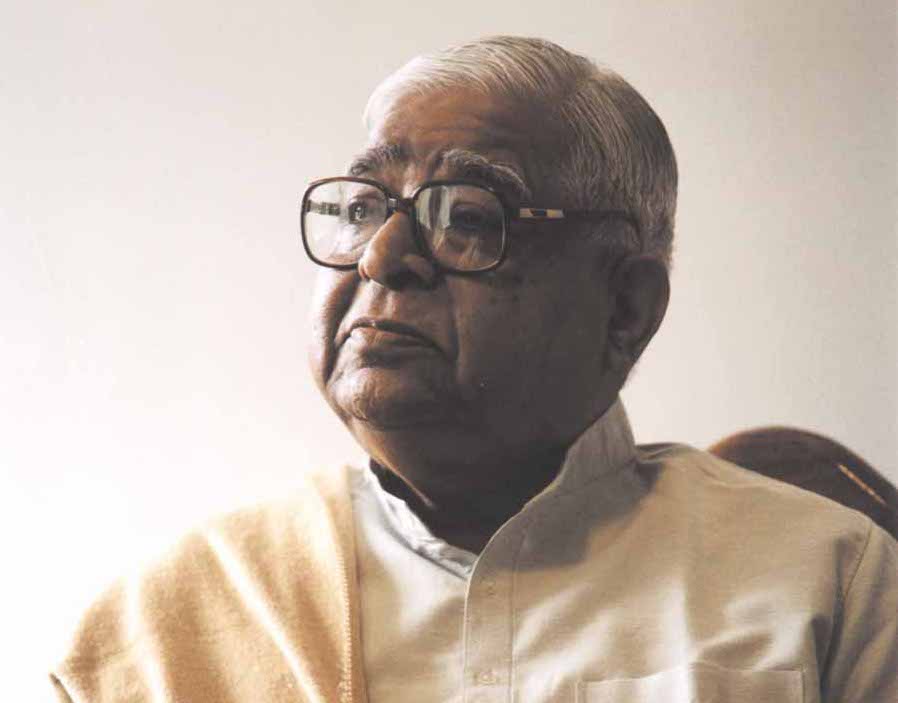S. N. Goenka transformed himself from successful businessman to a practitioner and teacher of meditation. That personal evolution would one day help spread traditional eastern concepts of mindfulness through the U.S.
Goenka championed the Vipassanā Movement, a modern and inclusive practice that helped to open the concept of meditation to the non-Buddhist world. He and his fellow Vipassanā champions would inspire a collection of meditation teachers in the West that would carry and boost the popularity of mindfulness into the 21st century.
S. N. Goenka: Stress Brought Him To Vipassanā
Born in Mandalay circa 1924 during the British imperial occupation of Burma (now Myanmar), Goenka grew up in a conservative Hindu home. During the mid-20th century, Eastern traditions of meditation were practiced primarily by monks and other religious figures — so the practices, philosophies and teachings that would define Goenka’s later life remained off limits to him for decades.
By all accounts a hard working and well-educated man, Goenka rose to significant success as a Burmese industrialist in the mid 1950’s. However, due to the stresses of the business world, he began suffering severe, debilitating headaches. A friend suggested meditation could calm the body and mind enough to relieve Goenka’s pain.
Growing up in a culture that looked on such practices as exclusively religious, ethereal and mysterious, Goenka was reluctant to try the non-traditional remedy, but eventually relented out of desperation to give the technique a try.
The Ancient Technique Of Vipassanā

In 1969, Goenka became a Vipassanā teacher himself. He would eventually become one of the most influential mindfulness teachers for the Western World.
Goenka approached teacher Sayagyi U Ba Khin, an instructor of the Vipassanā method. An ancient meditation technique within the Theravada tradition with roots dating back 2500 years, Vipassanā seeks insights into the true nature of reality. Records show the practice of its predecessor techniques ended in the 10th century, but underwent a resurgence within Burma around the 1700s.
The active roots of Vipassanā grew in the 19th and 20th centuries, centering on bare insight into the nature of life and reality. The word means “insight” in Sanskrit or “to see things as they really are” and serves as a particularly welcoming, inviting and gentle ways to explore the world of meditation.
Vipassanā searches for clear considerations of the “dukkha” or the nature of reality. Focusing on the familiar meditative concepts of suffering, the “non-self,” the impermanence of the human condition and related inherent emptiness, the tradition bases heavily on mindfulness, breathing techniques and reflection on the natural way of things.
Natural breath allows the mind to become focused on the connection between mind and body, opening up clear interpretations of the reality in which the body and mind coexist.
Breaking The Exclusivity Of Meditation
Legend has it the teacher Ba Khin was reluctant to take on a conservative businessman as a student, even if he was suffering from a physical malady. Eventually, Ba Khin agreed to teach the new pilgrim and found Goenka a worthy and focused student who would train under him for 14 years. Goenka would prove so dedicated to Vipassanā that Ba Khin would authorize him to become a teacher himself in 1969 – a declaration that would prove transformational to the student and the entire world.
Goenka found he could not return to the his old industrial world of business. Leaving his assembled fortune and belongings to his family, he moved to India to make a life out of teaching Vipassanā. He vowed to avoid the exclusivity of teaching only monks and priests and worked to bring meditation to the common people.
By 1976, he founded two meditation centers, teaching 10 day, devoted and intensive retreats. He worked exclusively on his own until 1982 when he began sharing his assembled Vipassanā experience and wisdom with assistant instructors. Once he had a team of other teachers educated in his methods, he opened the Vipassana Research Institute at Dhamma Giri in 1985 to explore ways to utilize the tradition in daily life.
Learn about the linguistic and auratic meaning of meditation.
Goenka And His Universal Approach
While all concepts of Vipassanā trace back to the Buddha and his teachings, Goenka’s practice never limits itself to a single religious tradition and welcomes all faiths and philosophies without any shred of magical or otherworldly trappings.
As Goenka himself put it in an early 2000 interview: “The Buddha never taught a religion, He taught Dhamma – the way to liberation — which is universal. He presented his teachings as non-sectarian and open to people of all faiths or no faith.”
Bringing Vipassanā To The West & Laying The Foundations Of Mindfulness
In the early 1980s, it became clear to Goenka that the inclusive and simplified nature of Vipassanā was accessible and popular with westerners. Coincidentally, the practice’s honoring of reality, the rejection of mythical trappings and the embracing of the natural world fit well with the classic tenets of the Stoics such as Seneca or Marcus Aurelius and the thinkers of the early Enlightenment such as Baruch Spinoza, Immanuel Kant, John Locke and Jean-Jacques Rousseau. In fact, the Enlightenment drove intellectual developments in Europe around the same time that Vipassanā was regaining prominence in the East.
Goenka began accepting and instructing westerners in the early 1980s, eventually teaching several thousand men and women who only had knowledge of colder, purely scientific methods until they discovered meditation.
Transitioning into the 1990s and 2000s, Goenka would spread Vipassanā practices internationally, training more than a thousand teachers to share his methods. His teachings would have a profound positive impact on the West, helping give birth to the 21st century understanding of mindfulness.
Get a sense of Vipassanā and mindfulness meditation with these handpicked, popular guided practices available for free on Insight Timer:
- Mindfulness Meditation Ram Dass 18:13
- Guided Basic Vipassana Meditation Tara Brach 15:27
- Guided Vipassana Meditation Rajesh Sengamedu 27:35
- Vipassana Body Sensing David Rees 22:11
- Quiet and Connected (Mindfulness Meditation) Joseph Goldstein 11:40
- Guided Vipassana Practice Hugh Byrne 26:18
S. N. Goenka’s Testimonial Lays In Each Minute Spent Meditating
Goenka either directly trained or greatly influenced such prominent meditation instructors as Sharon Salzberg, Ram Dass, Joseph Goldstein and Daniel Goleman.
An author of multiple books, Goenka served as a speaker at the Millennium World Peace Summit of Religious and Spiritual Leaders in 2000 at the General Assembly Hall of the United Nations and lectured at the World Economic Forum in Davos. For his life’s achievements, he received the Padma Bhushan, the third highest civilian honor of India.

Goenka’s teachings have influenced the most known meditation teachers of the present.
Goenka passed away on September 29, 2013. It is now estimated his teachings reached more than 1 million students to this day.
Explore Goenka’s influence on today’s meditation and discover thousands of free mindfulness meditation practices.







